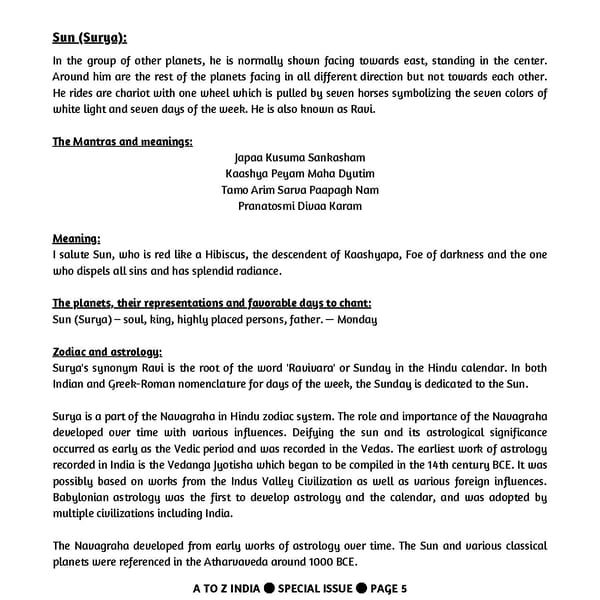A TO Z INDIA SPECIAL ISSUE PAGE 5 Sun (Surya): In the group of other planets, he is normally shown facing towards east, standing in the center. Around him are the rest of the planets facing in all different direction but not towards each other. He rides are chariot with one wheel which is pulled by seven horses symbolizing the seven colors of white light and seven days of the week. He is also known as Ravi. The Mantras and meanings: Japaa Kusuma Sankasham Kaashya Peyam Maha Dyutim Tamo Arim Sarva Paapagh Nam Pranatosmi Divaa Karam Meaning: I salute Sun, who is red like a Hibiscus, the descendent of Kaashyapa, Foe of darkness and the one who dispels all sins and has splendid radiance. The planets, their representations and favorable days to chant: Sun (Surya) – soul, king, highly placed persons, father. — Monday Zodiac and astrology: Surya's synonym Ravi is the root of the word 'Ravivara' or Sunday in the Hindu calendar. In both Indian and Greek-Roman nomenclature for days of the week, the Sunday is dedicated to the Sun. Surya i s a p art o f t he N avagraha in Hindu zodiac system. The role and importance of the Navagraha developed over time with various influences. Deifying the sun and its astrological significan ce occurred as early as the Vedic period and was recorded in the Vedas. The earliest work of astrology recorded in India is the Vedanga Jyotisha which began to be compiled in the 14th century BCE. It was possibly based on works from the Indus Valley Civilization as well as various foreign influences. Babylonian astrology was the first to develop astrology and the calendar, and was adopted by multiple c ivilizations including India. The Navagraha developed from early works of astrology over time. The Sun and various classical planets were referenced in the Atharvaveda around 1000 BCE.
 A TO Z INDIA - JUNE 2022 - SPECIAL ISSUE Page 4 Page 6
A TO Z INDIA - JUNE 2022 - SPECIAL ISSUE Page 4 Page 6